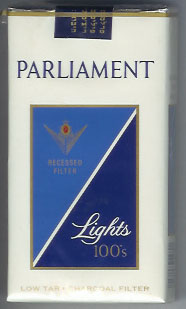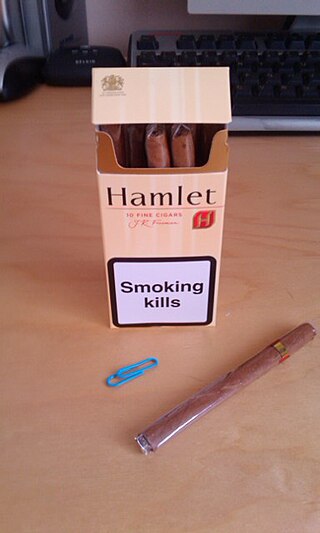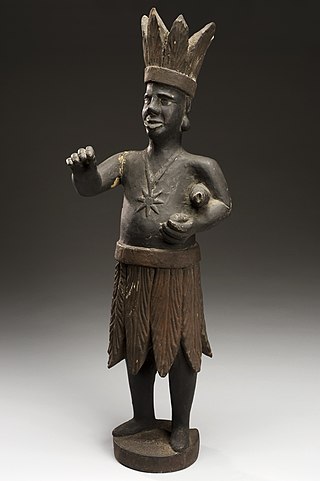
Parliament is an American brand of cigarettes, currently owned and manufactured by Philip Morris USA in the United States and Philip Morris International outside of the United States.
Virginia Slims is an American brand of cigarettes owned by Altria. It is manufactured by Philip Morris USA and Philip Morris International.
Benson & Hedges is a British brand of cigarettes owned by American conglomerate Altria. Cigarettes under the Benson & Hedges name are manufactured worldwide by different companies such as Rothmans, Benson & Hedges, Philip Morris USA, British American Tobacco, or Japan Tobacco, depending on the region. In the UK, they are registered in Old Bond Street in London, and were manufactured in Lisnafillan, Ballymena, Northern Ireland, before production was moved to Eastern Europe in 2017.
Capri is an American brand of cigarettes. It is currently owned and manufactured by the R. J. Reynolds Tobacco Company.

Chesterfield is a brand of cigarette, named after Chesterfield County, Virginia. The brand is owned by conglomerate Altria and produced by its subsidiary Philip Morris USA.

Gold Flake is a classic Indian cigarette brand that has been in the market for over a century.
Newport is an American brand of menthol cigarettes, currently owned and manufactured by the R. J. Reynolds Tobacco Company. The brand was originally named for the seaport of Newport, Rhode Island.

Silk Cut is a British brand of cigarettes, currently owned and manufactured by Gallaher Group, a division of Japan Tobacco. The packaging is characterised by a distinctive stark white packet with the brand name in a purple, blue, red, silver, white or green square.

Nicotine marketing is the marketing of nicotine-containing products or use. Traditionally, the tobacco industry markets cigarette smoking, but it is increasingly marketing other products, such as electronic cigarettes and heated tobacco products. Products are marketed through social media, stealth marketing, mass media, and sponsorship. Expenditures on nicotine marketing are in the tens of billions a year; in the US alone, spending was over US$1 million per hour in 2016; in 2003, per-capita marketing spending was $290 per adult smoker, or $45 per inhabitant. Nicotine marketing is increasingly regulated; some forms of nicotine advertising are banned in many countries. The World Health Organization recommends a complete tobacco advertising ban.

Salem is an American brand of cigarettes, currently owned and manufactured by ITG Brands, a subsidiary of Imperial Tobacco, inside the U.S. and by Japan Tobacco outside the United States.
Tareyton is an American brand of cigarettes, currently owned and manufactured by the R.J. Reynolds Tobacco Company.
Woodbine is a British brand of cigarettes which, as of 2019, is owned and manufactured by Imperial Tobacco. Woodbine cigarettes are named after the woodbine flowers, native to Eurasia.

Hamlet is a brand of cigar produced by the Gallaher Group division of Japan Tobacco. They are available in several varieties, miniatures and also a regular length. They were regularly referred to as the 'mild cigar' in their advertising.

Merit is an American brand of cigarettes, currently owned and manufactured by Philip Morris USA in the United States and Philip Morris International outside the United States.

There are approximately 57 million smokers in Indonesia, among a population of 273 million people. Around 63% of men and 5% of women report smoking, equating to 34% of the population. The majority, 88% of Indonesian smokers, use clove-flavoured kreteks. Kretek manufacturers directly employ over 180,000 people in Indonesia and an additional 10 million indirectly. Indonesia is the fifth largest tobacco market in the world, and in 2008 over 165 billion cigarettes were sold in the country.

blu is an electronic cigarette brand, produced by Fontem Ventures and owned by Imperial Brands. The brand blu sells various types of rechargeable and disposable e-cigarettes with a wide selection of flavored and unflavored liquids. Its products are available in many countries and each market offers different types of products suited to public demand and opportunities. The global headquarters of blu is located in Amsterdam. Local offices are active around the world to service all markets which sell the brand.
Mantano is a Dutch brand of unfiltered cigarettes, currently owned and manufactured by British American Tobacco.

As nicotine is highly addictive, marketing nicotine-containing products is regulated in most jurisdictions. Regulations include bans and regulation of certain types of advertising, and requirements for counter-advertising of facts generally not included in ads. Regulation is circumvented using less-regulated media, such as Facebook, less-regulated nicotine delivery products, such as e-cigarettes, and less-regulated ad types, such as industry ads which claim to discourage nicotine addiction but seem, according to independent studies, to promote teen nicotine use.

The history of nicotine marketing stretches back centuries. Nicotine marketing has continually developed new techniques in response to historical circumstances, societal and technological change, and regulation. Counter marketing has also changed, in both message and commonness, over the decades, often in response to pro-nicotine marketing.
Electronic cigarettes are marketed to smoking and non-smoking men, women, and children as being safer than cigarettes. E-cigarette businesses have considerably accelerated their marketing spending. All of the large tobacco businesses are engaging in the marketing of e-cigarettes. For the majority of the large tobacco businesses these products are quickly becoming a substantial part of the total advertising spending. E-cigarette businesses have a vested interest in maximizing the number of long-term product users. The entrance of traditional transnational tobacco businesses in the marketing of such products is a serious threat to restricting tobacco use. E-cigarette businesses have been using intensive marketing strategies like those used to publicize traditional cigarettes in the 1950s and 1960s. While advertising of tobacco products is banned in most countries, television and radio e-cigarette advertising in several countries may be indirectly encouraging traditional cigarette use.













